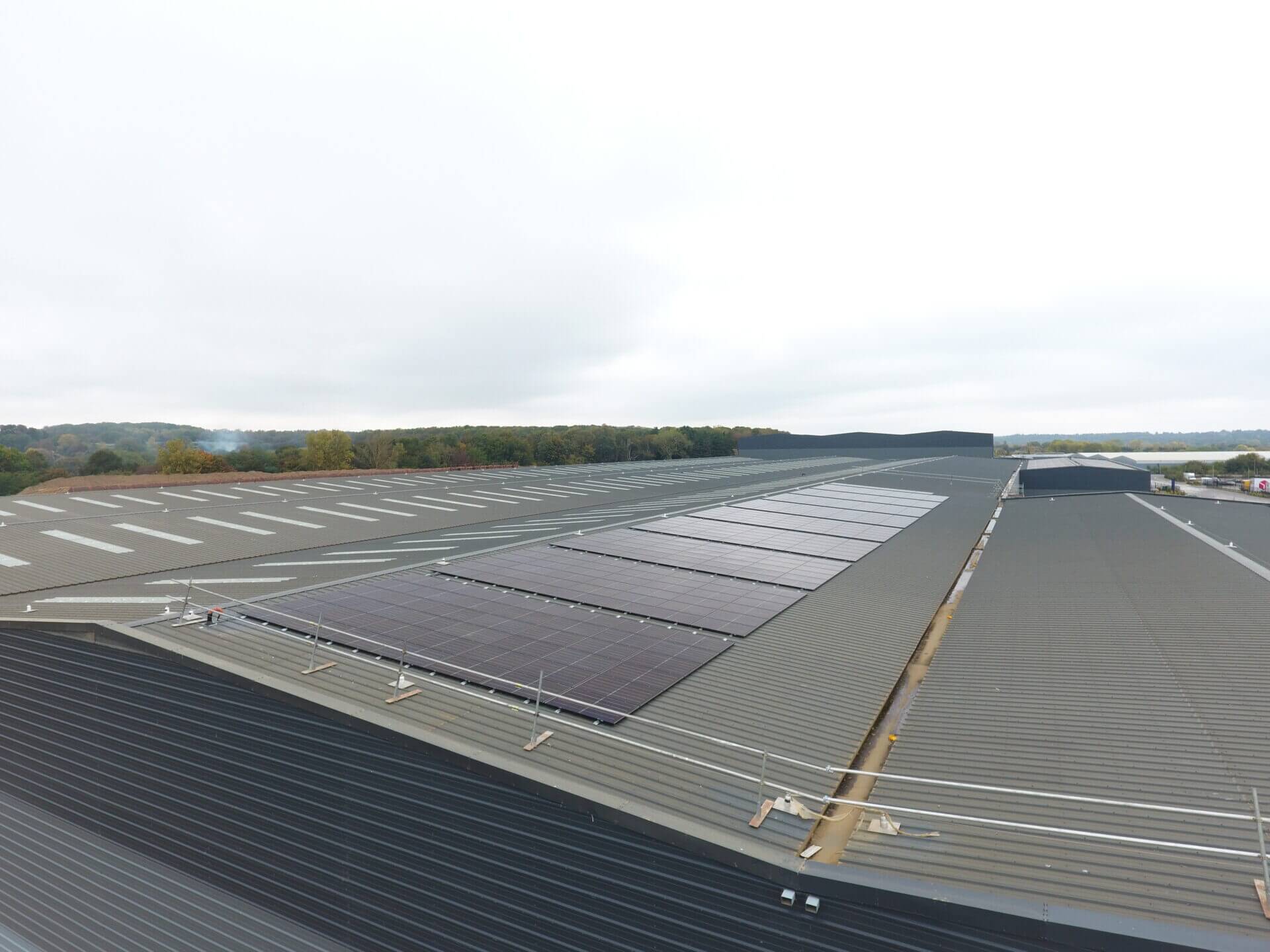Amidst the increasing focus on environmental sustainability and carbon reduction, our awareness of global environmental issues has grown significantly. The term “carbon footprint“ has emerged as a vital metric in our collective effort to combat climate change.
This article aims to provide an understanding of carbon footprint, including its measurement, sources, reduction strategies, and the role of global efforts. By learning about these aspects, individuals and businesses can make informed decisions to reduce their environmental impact. At EcoSolar, we work on reducing our carbon footprint. We also help others do the same by providing sustainable renewable energy solutions.
What is a Carbon Footprint?
A carbon footprint is the total amount of greenhouse gases (GHG), primarily carbon dioxide (CO2), emitted directly or indirectly by an individual, organisation, event, or product. These emissions come from various activities, such as burning fossil fuels for energy, transportation, deforestation, and industrial processes. The concept of a carbon footprint helps quantify the environmental impact of these activities, providing a tangible measure to track and reduce contributions to climate change.

How Do We Measure Carbon Emissions?
Accurately measuring carbon emissions is the first step in managing and reducing our carbon footprint. Several tools and methodologies are available to facilitate this process:
- Carbon Calculators: Online tools that estimate emissions based on factors like energy use, travel, and waste generation. These calculators provide a user-friendly way for individuals and businesses to assess their carbon footprint.
- Life Cycle Assessment (LCA): A comprehensive method that evaluates the environmental impacts associated with all stages of a product’s life cycle, from raw material extraction to disposal. This approach helps identify emissions hotspots and opportunities for improvement.
- Greenhouse Gas Protocol: An internationally recognised framework for measuring and managing GHG emissions. It provides standardised guidelines for organisations to report their carbon footprints accurately.
By using these tools, we can understand the sources and magnitude of our emissions, allowing us to take targeted actions to reduce them.
What are the Sources of Carbon Footprints?
Understanding the sources of carbon emissions is essential for developing effective reduction strategies. The main contributors to carbon footprints include:
- Energy Consumption: Burning fossil fuels for electricity, heating, and transportation is a significant source of CO2 emissions. This includes residential, commercial, and industrial energy use.
- Food Production: Agricultural practices, livestock farming, and food processing contribute to GHG emissions through methane and nitrous oxide released during production and transportation.
- Transportation: Emissions from cars, lorries, airplanes, and ships account for a substantial portion of global carbon footprints. Efficient transportation systems and alternative fuels can help mitigate these emissions.
- Industrial Processes: Manufacturing and construction activities release GHGs, particularly from cement production, chemical processing, and metal refining.
- Waste Management: Decomposition of organic waste in landfills generates methane, a potent greenhouse gas. Proper waste management practices can significantly reduce these emissions.
Identifying these sources allows us to prioritise actions and implement strategies to reduce emissions effectively.

How Can We Reduce Our Personal Carbon Footprint?
Taking responsibility for our personal carbon footprint and adopting sustainable practices into our lifestyle can make a significant difference. Here are some practical steps individuals can take:
- Use Energy-Efficient Appliances: Opt for appliances with high energy efficiency ratings. This reduces electricity consumption and lowers emissions.
- Transportation: Choose walking, cycling, or public transport to reduce emissions from transportation.
- Reduce Waste: Practice recycling, composting, and minimising single-use plastics. Reducing waste helps lower methane emissions from landfills.
- Sustainable Dietary Choices: Reduce meat and dairy consumption, as livestock farming is a major source of methane emissions. Opt for locally sourced, organic produce to reduce transportation emissions.
- Conscious Consumption: To help the environment, choose eco-friendly brands. Opt for pre-owned goods. Prioritise purchasing products of superior quality rather than acquiring in bulk.
Small lifestyle changes, when adopted collectively, can lead to significant reductions in carbon emissions.
What Strategies Can Be Used for Carbon Reduction?
Businesses play a critical role in reducing carbon footprints by adopting sustainable practices. Here are some effective strategies:
- Use energy-efficient technologies like LED lighting and energy management systems to save energy in offices and warehouses. Ecolighting offers a range of lighting solutions to reduce your energy consumption
- Utilise Renewable Energy: Install solar panels and solar batteries to generate clean energy, reducing reliance on fossil fuels. EcoSolar offers a range of solar solutions tailored to meet your energy needs.
- Encourage Sustainable Practices Among Employees: Promote eco-friendly behaviours, such as reducing paper use, carpooling, and recycling, within the workplace.
- Carbon Offsetting: Offset unavoidable emissions by investing in projects that remove or reduce GHGs. This includes reforestation, renewable energy projects, and methane capture from landfills.
- Sustainable Supply Chain: Partner with suppliers who adhere to environmental standards and promote sustainable practices throughout the supply chain.
By implementing these strategies, businesses can reduce their carbon footprint and demonstrate their commitment to sustainability.
How to Balance Emissions Through Carbon Offsetting?
Carbon offsetting involves investing in projects that reduce or eliminate the same amount of CO2 emissions from the air. This helps to balance out the emissions.
By supporting these projects, individuals or companies can offset their carbon footprint. This means they are taking action to reduce the impact of their carbon emissions on the environment. Common offset projects include:
- Reforestation: Planting trees to absorb CO2 and restore natural ecosystems.
- Renewable Energy: Supporting wind, solar, and hydroelectric projects that displace fossil fuel-based energy generation.
- Methane Capture: Implementing technologies to capture methane emissions from landfills and agricultural operations.
- Energy Efficiency Programs: Funding initiatives that improve energy efficiency in buildings, industries, and communities.
Carbon offsetting is not a substitute for reducing emissions. It can, however, help offset unavoidable emissions. Additionally, it can support global climate initiatives.
What Solutions are Available for Carbon Capture and Storage?
Technological innovations offer promising solutions for capturing and storing carbon emissions, preventing them from entering the atmosphere. Key advancements include:
- Direct Air Capture (DAC) is a process that removes CO2 from the air and either turns it into useful products or stores it.
- Carbon Capture and Storage (CCS) is the process of capturing CO2 emissions from factories and power plants. The captured emissions are then stored underground.
- Enhanced Weathering accelerates the natural processes that remove CO2 from the atmosphere by spreading finely ground minerals over large areas of land or ocean surfaces.
These technologies hold great promise for reducing atmospheric CO2 levels, but widespread adoption and investment are needed to realise their full potential.

What’s Happening with Global Efforts in Addressing Climate Change?
Climate change is a global challenge that requires coordinated efforts across nations. International collaboration is essential for achieving meaningful progress in reducing carbon footprints and mitigating environmental impact. Key global initiatives include:
- The Paris Agreement: A landmark accord adopted by nearly 200 countries to limit global warming to well below 2°C above pre-industrial levels, with an aspiration to limit the increase to 1.5°C.
- United Nations Framework Convention on Climate Change (UNFCCC): An international treaty aimed at stabilising GHG concentrations in the atmosphere to prevent dangerous anthropogenic interference with the climate system.
- Sustainable Development Goals (SDGs): A set of 17 global goals established by the United Nations to address urgent environmental, social, and economic challenges, including climate action (Goal 13).
International collaboration involves sharing knowledge, resources, and technologies to accelerate climate action and support vulnerable communities in adapting to climate impacts.
In conclusion
Understanding and addressing our carbon footprints is crucial for mitigating climate change and protecting our planet for future generations. By measuring our emissions, identifying key contributors, and implementing targeted strategies, we can significantly reduce our environmental impact.
At EcoSolar, we are committed to promoting sustainable practices and helping businesses reduce their carbon footprints through innovative renewable energy solutions. From individual actions to corporate responsibility and international collaboration, every effort counts in the fight against climate change.

